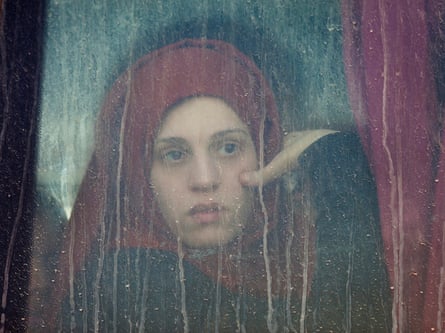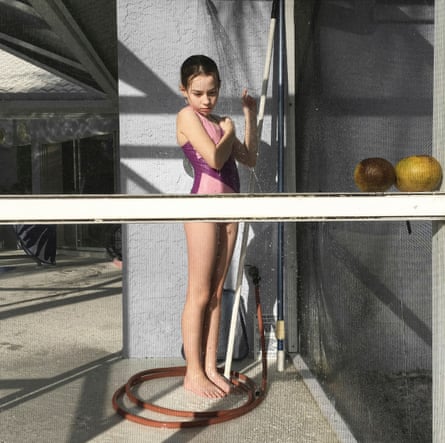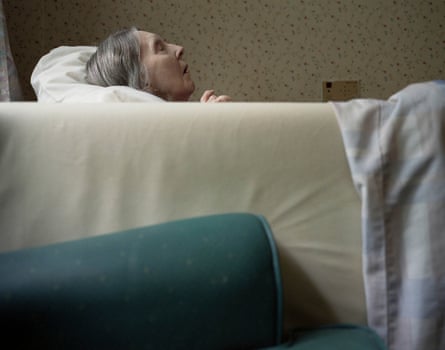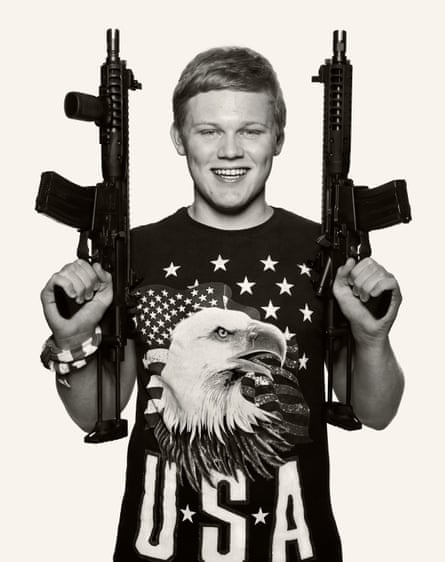A handful of politicians, several refugees, various awkward adolescents, two skinheads, the inevitable young girl holding a furry animal and, breaking with tradition, an android – it’s the Taylor Wessing time of year again.
This year’s photographic portrait prize, the first to allow digital submissions as well as prints, draws 59 images from 5,717 entries. As a show, it hangs together pretty well, not always the case in the past. The overall standard seems higher, there are fewer celebrities – always a good thing – and most of the portraits of refugees and asylum-seekers tend towards the intimate rather than the concerned.
Abbie Trayler-Smith’s shortlisted image of an unnamed young woman in a red headscarf, lost in thought as she gazes through the grime-smeared window of an Oxfam transport bus, is perhaps the most intimately powerful image. The woman’s face is a landscape of emotions – uncertainty, bewilderment, relief and anxiety, while the full frame composition and muted colours of the red scarf and matching curtains imbue it with an almost holy feel.

It certainly makes for an interesting contrast with the winning image, César Dezfuli’s striking portrait of 16-year-old Amadou Sumaila, who had just been rescued from the sea off the Libyan coast by a European vessel, apparently fulfilling his dream of starting a new life. He confronts the camera with an unflinching gaze that cannot quite hide his trauma and his conflicting mixture of emotions. The judges praised the portrait for the unsettling directness of Sumaila’s gaze and the way in which it “powerfully conveys his loss, solitude and determination”. Both portraits speak of the tumultuous drama of human migration in different ways, one quietly, the other forcefully.

More problematically intriguing is the third shortlisted portrait of Erica, an android in Finnish artist Maija Tammi’s series One of Them Is a Human, about the artificial intelligence research undertaken by Hiroshi Ishiguro Labs in Osaka, Japan. Erica, alas, looks too synthetic and soulless to convince me that this is a great portrait. An interesting photograph, certainly, but there is something too generic here, a lack of presence that makes it seem almost a novelty. To be fair, it works much better as part of Tammi’s extended series.
Elsewhere, there are several strong but subtle portraits that could easily have made the shortlist. I was arrested by Alys Tomlinson’s stark and severe monochrome portrait of Markus, an Austrian youth in an Order of Malta uniform, whom she photographed at the pilgrimage site at Lourdes, in the foothills of the Pyrenees.

The image, made on a large format camera, has a deeply still, oddly ominous quality, perhaps due to the quasi-military uniform and the subject’s awkwardness. If there are conscious echoes of Diane Arbus and August Sander here, they add to the image’s captivating power, the suggestion that Markus seems to have stepped out of another time. For my money, it is one of the strongest portraits, formally and atmospherically, in the show.
Likewise, Matthew Finn’s haunting study of his elderly mother, Jean, in profile, her head lying still against a propped up pillow, suspended in a void caused by creeping dementia. You can almost sense his trepidation as he willed himself to create this transgressively powerful image of helplessness.
I was also intrigued by the various portraits of children and adolescents in the exhibition, given that the former have all but disappeared from the street photography genre in which they once abounded – who would dare point a camera at a child in our suspicious and over-protective culture? – and the latter always make for interestingly gauche subjects.

Debbie Naylor’s portrait of 14-year-old Mickey, outwardly confident but awkward, is a perfectly pitched case in point. Even more so Monika Merva’s beautifully observed snatched phone portrait of her daughter in a swimsuit showering behind an outdoor screen. It is a tenderly observed study of a young girl lost in reverie, but the play of diagonal shadow lines and the geometry of the coiled shower hose and two apples perched in the foreground speak of a singular eye for the everyday sublime.
Amid all this quiet engagement with mood and atmosphere, the inevitable images of Donald Trump and Hillary Clinton, and an effortlessly self-satisfied David Cameron adjusting his tie in a mirror, are a jolting reminder of another more vulgar reality. Laurent Elie Badessi’s straightforward black and white portrait of a 16-year-old Texan youth, George, grinning widely as he holds up two automatic weapons more suited to armed combat than hunting, is shocking only in its brazenness. It is as American in its warped way as the proverbial apple pie.

In a T-shirt bearing the symbolic bald eagle that signifies American power and freedom, George seems blissfully happy as if posing for a graduation photo. No adolescent awkwardness or self-doubt here, but, like all the young people in this exhibition – the refugees, the Catholic volunteer, the gangly kids caught between childhood and tentative adulthood – you wonder what will become of him. Only synthetically serene Erica looks immune from the all-too-human uncertainty that lies in wait.









Comments (…)
Sign in or create your Guardian account to join the discussion